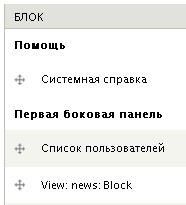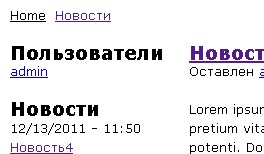Drupal 7 hook_block_info() and hook_block_view() display information in the block
In the previous lesson, we created a module for Drupal 7. In this lesson, we will continue to enhance our module. We’ll add a block output using hook_block_info() and hook_block_view(). This block will display the latest users on the site, each with a link to their profile page.
Let's start with a description of hook_block_info():
Defines all the blocks created by the module.
This hook tells Drupal which blocks the module will display and can also describe block configuration options.
In hook_block_info(), each block is assigned a unique identifier called "delta" (the keys in the returned array). The delta value must be unique within your module and is used for the following:
- Passed to other block hooks as an argument to identify the block to be configured or rendered.
- Used to create a block template file
block-MODULE-DELTA, which Drupal applies for styling and scripting. - Used to define theming functions
block__MODULE__DELTAfor advanced theming. - Used to identify your block in
hook_block_info_alter()and other related hooks.
Delta can be a string or integer, and its maximum length is 32 bytes.
Return Values
An associative array where each key is a delta, and its value is a description array. Each description array can contain the following key-value pairs:
- 'info' (required): A human-readable name of the block, shown in the admin interface.
- 'cache' (optional): Describes block caching behavior. Options include:
- DRUPAL_CACHE_PER_ROLE (default): Cache based on user role.
- DRUPAL_CACHE_PER_USER: Cache based on user ID.
- DRUPAL_CACHE_PER_PAGE: Cache based on page.
- DRUPAL_CACHE_GLOBAL: Same cache for all users and pages.
- DRUPAL_NO_CACHE: Block will not be cached.
- 'properties' (optional): Additional metadata array. Includes:
- 'administrative': Boolean indicating if the block is for admin purposes.
- 'weight': Block weight value.
- 'status': Initial status (1 = enabled, 0 = disabled).
- 'region': Initial region placement.
- 'visibility': Block visibility rule (e.g., listed pages, not listed pages, or PHP code).
- 'pages': A list of paths relevant to the visibility setting.
Let’s add a block with this hook:
The block should now appear in the admin interface. Let's add it to the left sidebar:

Now that we have added the block, let's define its content using the hook_block_view() hook.
hook_block_view($delta = ''):
Parameters
$delta — Identifies which block is being rendered. This matches the delta returned by hook_block_info().
Return Value
An array with the following elements:
- subject: The block title. If no title is needed, return NULL.
- content: The body of the block, either as a renderable array (preferred) or raw HTML string.
Let’s implement this hook:
fields('u', array('uid', 'name')) // select uid and name
->orderBy('u.uid', 'DESC') // order by uid descending
->range(0, 5) // limit to 5 users
->execute(); // execute the query
$users = $query->fetchAll(PDO::FETCH_ASSOC); // fetch results
foreach ($users as $user) {
$block['content'] .= '
'; // base_path() returns the base path of the Drupal site } break; } return $block; } ?>
This will output the 5 most recently registered users on the site, each as a link to their profile. Of course, it's better to use the l() function for creating links, but that deserves a separate article.
